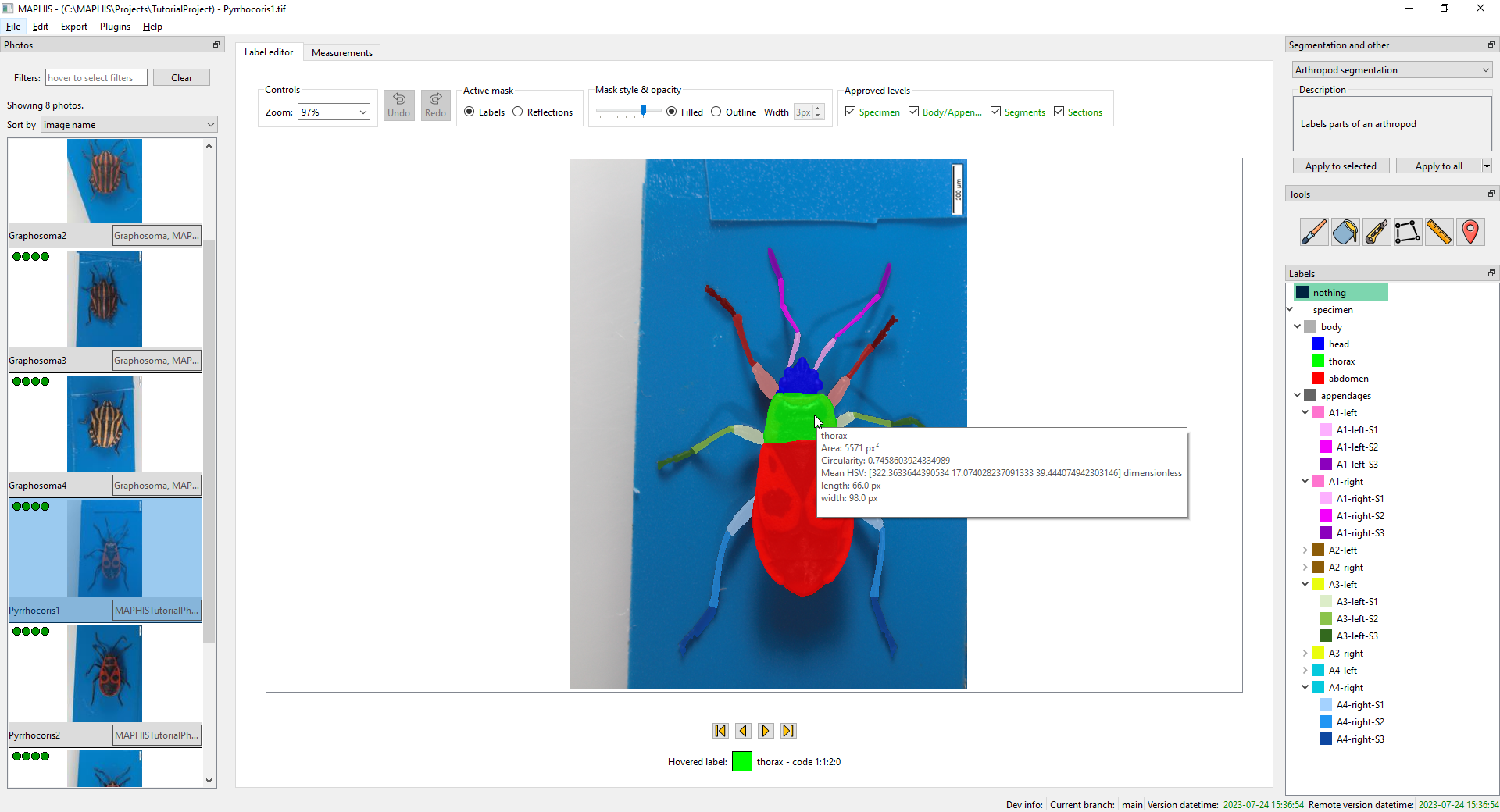Introduction
MAPHIS is a GPL open-source application that allows you to automatically or manually perform hierarchical segmentation of arthropod photos, and to extract various measurements describing the size, shape, colour, or texture properties of their individual body parts.
The application is not limited only to arthropod photos. With a different segmentation plugin or using manual editing, even photos from completely unrelated domains can be processed.
Installing and running on Windows
For Windows users we provide a convenient distribution package at: https://cbia.fi.muni.cz/files/software/maphis/maphis.zip.
Extract the contents of the downloaded zip-file at a destination of your choosing and run MAPHIS by executing the file maphis.exe inside the extracted folder.
NOTE: This way of obtaining and running MAPHIS is the most convenient. However, because of the way the distribution is generated, you may encounter that MAPHIS freezes when clicking on labels in the Labels tree view (it does not happen on all machines, though). As far as we know this problem is not MAPHIS-specific and is currently out of our hands, and therefore if you do encounter such a problem, we recommend looking at the alternative ways of installing MAPHIS detailed in the sections below.
Alternative ways of installing MAPHIS
The next two sections detail how to install MAPHIS either through the Python Package Index or git. The required prerequisite for both of these ways is to have the Python interpreter installed. You can obtain Python from https://www.python.org/. MAPHIS is compatible with Python versions 3.8 or later, however it was developed and extensively tested mainly with Python 3.8.
Virtual environment
As MAPHIS contains a few dependencies, their versions might clash with versions of the same dependencies that you already may have installed in your Python environment. To prevent this, we recommend installing MAPHIS (and it is generally a good practice for other big projects) in its own virtual environment (see https://realpython.com/python-virtual-environments-a-primer/#why-do-you-need-virtual-environments for further explanation).
The steps below describe how to create a virtual environment using the miniconda manager. Virtual environment management can be also achieved with the modules venv (https://docs.python.org/3/library/venv.html) or virtualenv (https://virtualenv.pypa.io/en/latest/).
-
Download and install
minicondafor your operating system from https://docs.conda.io/projects/conda/en/latest/user-guide/install/index.html. -
Open up
Anaconda Powershell PromptorAnaconda Prompt(Windows) or your terminal emulator (Linux). -
In the prompt, create a new virtual environment called
maphiswith Python 3.8 (you can change the version inpython=3.8as you like, it should be 3.8 or higher, though):conda create -n maphis python=3.8
Alternative 1: Installing from PyPI and running from command line (Linux, Windows)
In this section we describe how to obtain MAPHIS from the Python Package Index(PyPI).
Installation
- Activate the virtual environment:
conda activate maphis - Install the app:
python -m pip install maphis
Running
- Activate the virtual environment:
conda activate maphis - Start
MAPHISlike so:python -m maphis
Alternative 2: For developers - cloning the git repository
Installation
- Clone the repository from https://gitlab.fi.muni.cz/cbia/maphis
- Go to the root directory of the cloned repository
- Activate the virtual environment:
conda activate maphis - Install the requirements:
python -m pip install -r requirements.txt - Install the app in editable mode:
python -m pip install -e .
Running
- Activate the virtual environment:
conda activate maphis - Go to the root directory of the cloned repository
- Run:
python maphis/__main__.py
Or you can alternatively run MAPHIS with python -m maphis after Step 1.
